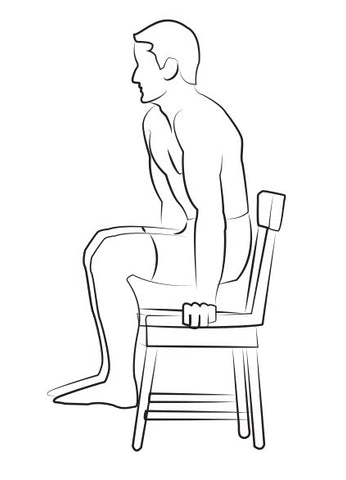Simple Self Help Tips for Common Shoulder Pain
Strengthening and Rehabilitation Exercises for the Supraspinatus - Dr. Jonathan Kuttner
The rotator cuff is a frequent source of pain that is common in both young athletes and middle-aged people
One of the most common physical complaints is shoulder pain. The shoulder is made up of several joints combined with tendons and muscles that allow a great range of motion in your arm.
Because so many different structures make up the shoulder, it is vulnerable to many different problems.
The rotator cuff is a frequent source of pain that is common in both young athletes and middle-aged people. Young athletes who use their arms overhead for swimming, baseball, and tennis are particularly vulnerable.
Those who do repetitive lifting or overhead activities using the arm, such as paper hanging, construction, or painting are also susceptible.
If shoulder pain persists, it is always important to get it examined by a suitable qualified medical or healthcare practitioner.
After discussing your symptoms and medical history, he or she will check to see if your shoulder is tender in any particular area or whether there is a deformity.
You will also need to perform some simple exercises which are designed to test your range of motion and strength, and to help rule out other conditions, such as arthritis.
Most cases of shoulder pain are linked to shoulder impingement or rotator cuff tendinitis. Most of these can be treated effectively with a combination of trigger point therapy and specific strengthening exercises.
Below you'll find 5 simple exercises that can often help provide relief and accelerate the healing process.
1. Pendulum Exercises

Let the arm dangle. Make 20 small circles counter clockwise, and then 20 clockwise. Keep the circles small. Start to integrate forward to back, and side to side motions.
2. Active Assisted Range of Motion


Hold the cane with both hands (a broom stick can work if you have the space). Elevate the arms using the healthy arm to guide the injured arm. Increase use of the injured arm as directed by comfort. Do this standing or lying down.
3. Rotations


Option A (Left) External Rotation. Secure an exercise band at waist level. Hold the elbow at 90 degrees and the arm at the side. Slowly pull the hand away from the body.
Option A (Right) Internal Rotation. Secure an exercise band at waist level. Hold the elbow at 90 degrees and the arm at the side. Slowly pull the hand across the body.
Option B (Left) External Rotation. Lay down on your side, involved side up. Arm at side. Elbow bent with or without weight. Slowly move the hand up as shown.
Option B (Right) External Rotation. Lay down on involved side. Elbow bent at 90 degrees and arm at side. With or without weight slowly pull hand inward across the body as shown.
4. Chair Press

While seated, try to lift your body off the chair. Try to keep your back as straight as possible. Repeat 3 to 10 times or to your comfort level.
5. Rows

You can do this exercise seated or standing. Secure an exercise band. Bend your elbows back and try to pinch your shoulder blades. Repeat 3 to 10 times or to your comfort level.
Good luck ... and please remember to always start slowly!
Find a Trigger Point Professional in your area
Dry Needling for Trigger Points
Certify as a Trigger Point Therapist
Trigger Point Therapy Course Packs:
This trigger point therapy blog is intended to be used for information purposes only and is not intended to be used for medical diagnosis or treatment or to substitute for a medical diagnosis and/or treatment rendered or prescribed by a physician or competent healthcare professional. This information is designed as educational material, but should not be taken as a recommendation for treatment of any particular person or patient. Always consult your physician if you think you need treatment or if you feel unwell.
About Niel Asher Education
Niel Asher Education (NAT Global Campus) is a globally recognised provider of high-quality professional learning for hands-on health and movement practitioners. Through an extensive catalogue of expert-led online courses, NAT delivers continuing education for massage therapists, supporting both newly qualified and highly experienced professionals with practical, clinically relevant training designed for real-world practice.
Beyond massage therapy, Niel Asher Education offers comprehensive continuing education for physical therapists, continuing education for athletic trainers, continuing education for chiropractors, and continuing education for rehabilitation professionals working across a wide range of clinical, sports, and wellness environments. Courses span manual therapy, movement, rehabilitation, pain management, integrative therapies, and practitioner self-care, with content presented by respected educators and clinicians from around the world.
Known for its high production values and practitioner-focused approach, Niel Asher Education emphasises clarity, practical application, and professional integrity. Its online learning model allows practitioners to study at their own pace while earning recognised certificates and maintaining ongoing professional development requirements, making continuing education accessible regardless of location or schedule.
Through partnerships with leading educational platforms and organisations worldwide, Niel Asher Education continues to expand access to trusted, high-quality continuing education for massage therapists, continuing education for physical therapists, continuing education for athletic trainers, continuing education for chiropractors, and continuing education for rehabilitation professionals, supporting lifelong learning and professional excellence across the global therapy community.

Continuing Professional Education
Looking for Massage Therapy CEUs, PT and ATC continuing education, chiropractic CE, or advanced manual therapy training? Explore our evidence-based online courses designed for hands-on professionals.



















